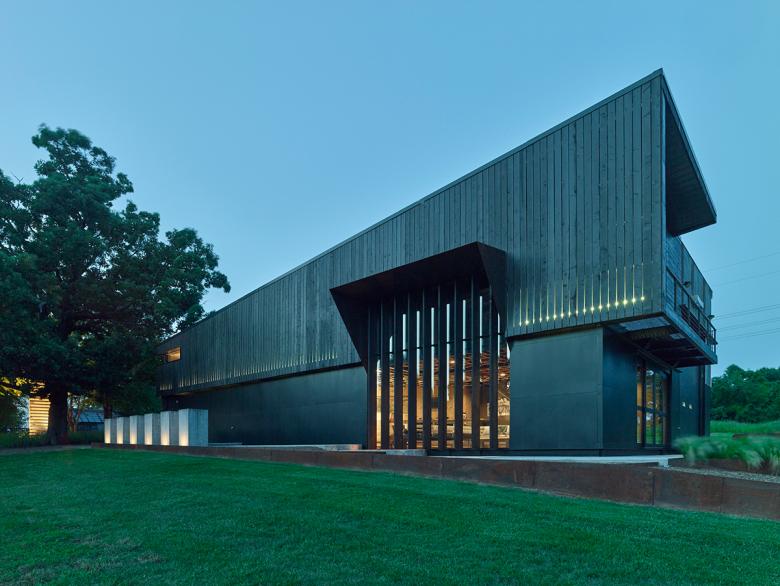Modus Studio
Manzeum
Photo: Timothy Hursley
The name of this project in Fayetteville, the city that is home to the University of Arkansas, appears to fuse the "man cave" – the bastion of masculinity carved from garages, basements or other spaces in suburban houses – and the museum. Sitting on a sizable twenty-acre site, the Manzeum incorporates numerous spaces for play and art through the renovation and expansion of an existing structure. The architects at Modus Studio answered a few questions about the project.
Location: Fayetteville, Arkansas
Client: Brandon and Josie White
Architect: Modus Studio
Design Principal: Chris Baribeau, AIA
Project Team: Chris Baribeau, AIA; Leanne Baribeau, AIA
Contractor: Owner
Site Area: 20 acres
Building Area: 3,446 sf
Before
What were the circumstances of receiving the commission for this project?
The project was commissioned as a mutual reciprocation between the owner and the architect who have worked together on many personal, residential, and commercial projects over the years. Implicit trust for the craft that each carries in their daily work became the foundation of the open communication and hands-on detailing throughout construction.
Construction
Please provide an overview of the project.
The Manzeum is part of a multi-phased project in an ongoing collaboration derived from the energetic and artistic minds of the owners and the editorial will of the architect. The current master plan plunges the Manzeum addition toward the developing landscape of the 20-acre site. The central roundabout is the primary orienting device for all the constructed elements on the site. The center is marked by a stacked concrete totem, foreshadowing of the intriguing and artistic follies to be discovered throughout the property.
Master Plan (Drawing: Modus Studio)
The "working drawings" are a collection of sketches and technical shop drawings (the second and third cousins to the napkins sketch) produced by the architect and owner alike. The meat of the design strategies and details were hashed out in real time on the site between owner, architect, and fabricators.
"Big dumb wood box" concept sketches (Drawing: Modus Studio)
What are the main ideas and inspirations influencing the design of the building?
It’s okay. The Manzeum is not intended as social commentary. It is a structure focused on play, art, and good times. The proverbial "napkin sketch" becomes reality in this collaborative design, fabrication, and construction project where the artistic metalworks of the owner and modern designs of the architect merge seamlessly into an evolved Ozark aesthetic.
Photo: Timothy Hursley
How does the design respond to the unique qualities of the site?
The existing rustic studio and workshop are transformed into a strong, modern form that unites with the raw agricultural base of the original spaces. The strong and raw palette of concrete, steel, and cedar are extensively intertwined. The "big dumb wood box" concept is the organizing element in a patchwork of naturally weathering and painted steel. A dual personality exposure between tectonic workshop space and entertainment space is created, crafted, embellished, and enjoyed. Old versus new is continually merged on the interior spaces while the new fire pit terrace provides steel containment as the overall structure is carved into the evolving landscape.
Photo: Timothy Hursley
How did the project change between the initial design stage and the completion of the building?
The initial napkin sketch concept quickly evolved into built reality through a very hands-on and communication-driven process. The original idea of the "big dumb box" was a driving force for decision-making, where the simplest but most potent construction solution is ultimately what was fabricated.
Photo: Timothy Hursley
What products or materials have contributed to the success of the completed building?
The implicit nature of the wood, steel and glass are the direct expression of the owner’s personal life and the ideas behind the design. These three materials take many forms throughout the building, from raw to refined and at various scales.
Email interview conducted by John Hill.
Photo: Timothy Hursley
Photo: Timothy Hursley
Photo: Timothy Hursley
Photo: Timothy Hursley
Floor plan sketches (Drawing: Modus Studio)
Artículos relacionados
-
Initiative Rising Star – School Buildings for Hopley, Zimbabwe
Engineers Without Borders Germany | 04.11.2024 -
-












